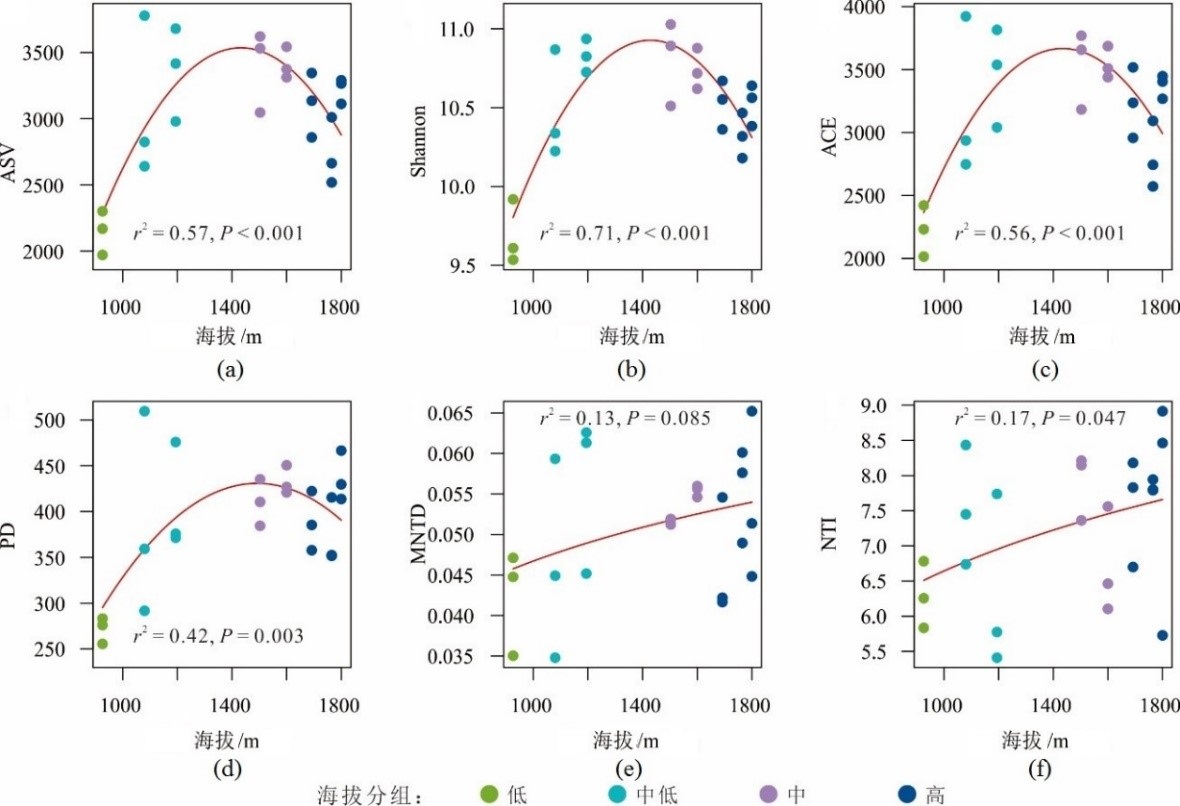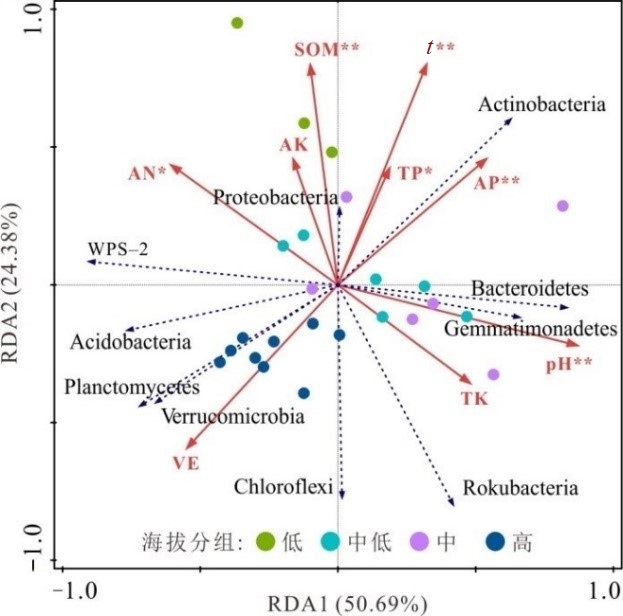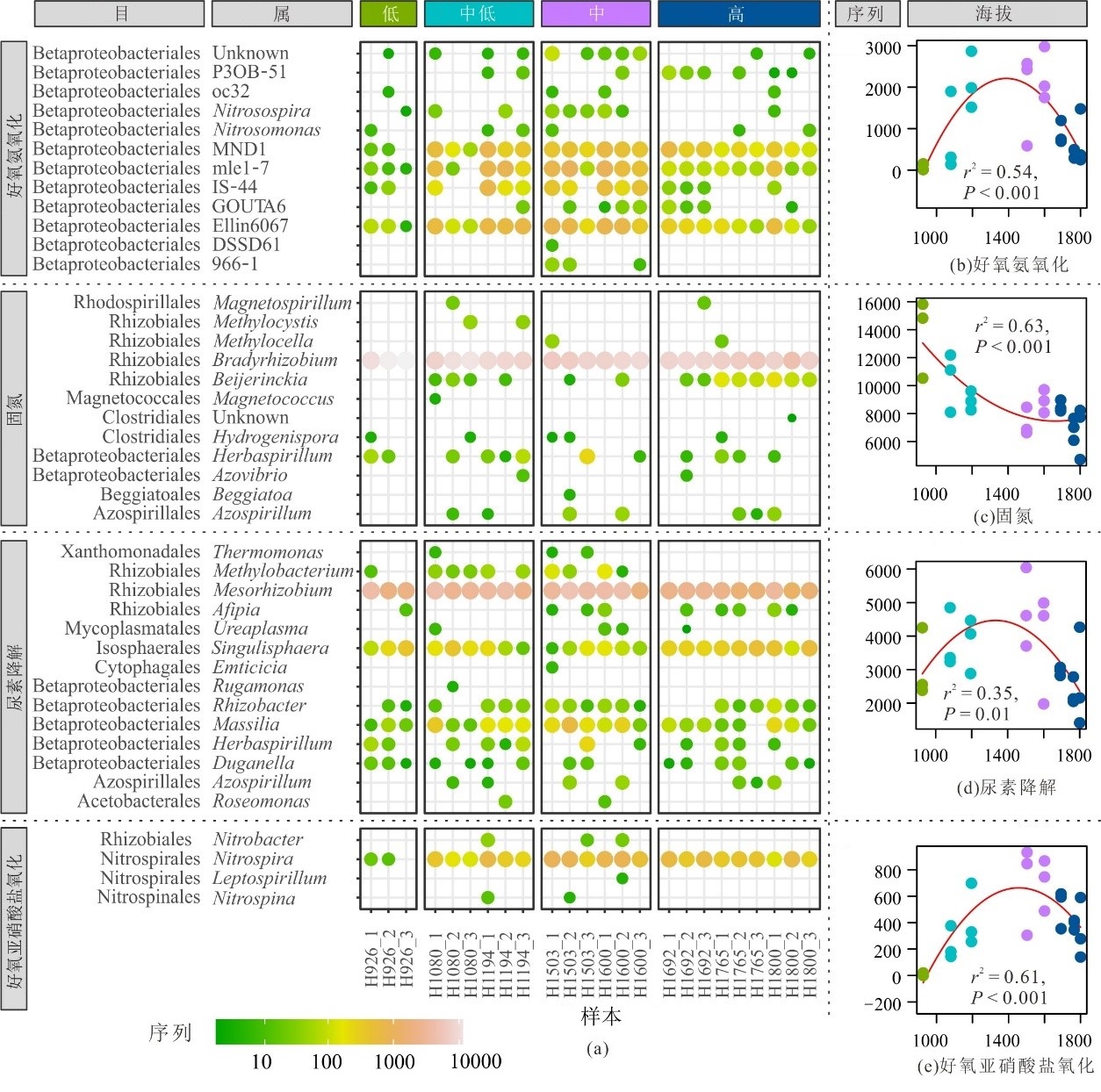生态环境学报 ›› 2023, Vol. 32 ›› Issue (1): 56-69.DOI: 10.16258/j.cnki.1674-5906.2023.01.007
向兴1,2( ), 满百膺1,2,*(
), 满百膺1,2,*( ), 张俊忠3, 罗洋1, 毛小涛1, 张超1, 孙丙华2, 王希2
), 张俊忠3, 罗洋1, 毛小涛1, 张超1, 孙丙华2, 王希2
收稿日期:2022-06-09
出版日期:2023-01-18
发布日期:2023-04-06
通讯作者:
*满百膺(1979年生),男,副教授,博士,研究方向为环境微生物。E-mail: shmilying@126.com作者简介:向兴(1989年生),男(苗族),讲师,博士,研究方向为微生物生态学。E-mail: xiangxing1989@126.com
基金资助:
XIANG Xing1,2( ), MAN Baiying1,2,*(
), MAN Baiying1,2,*( ), ZHANG Junzhong3, LUO Yang1, MAO Xiaotao1, ZHANG Chao1, SUN Binghua2, WANG Xi2
), ZHANG Junzhong3, LUO Yang1, MAO Xiaotao1, ZHANG Chao1, SUN Binghua2, WANG Xi2
Received:2022-06-09
Online:2023-01-18
Published:2023-04-06
摘要:
山地生态系统是研究土壤微生物垂向变化规律的天然场所,受采样空间尺度、样本异质性、测序深度、变化的生态因子、环境参数及多样性度量指数等因素的制约,目前对该系统土壤细菌群落及氮循环功能群垂向分异格局的认识仍然薄弱。以植被和土壤垂直分带明显的黄山为研究对象,选取海拔926—1800 m的典型森林土壤样本,采用Illuminia HiSeq高通量测序技术获取土壤细菌群落信息,在生物信息学分析中引入谱系结构指数(MNTD和NTI),结合土壤理化参数及FAPROTAX功能预测手段,探究黄山森林土壤细菌群落多样性和氮循环功能群垂向变化的潜在规律。结果显示,(1)变形菌门(Proteobacteria,44.77%)、酸杆菌门(Acidobacteria,21.85%)和放线菌门(Actinobacteria,14.88%)为优势细菌门类,其垂向分布依次呈现递减式、“U”型式和单峰式。(2)细菌群落的物种多样性指数和谱系多样性指数的空间垂向分布呈单峰模式。(3)谱系结构指数分析揭示细菌群落的系统发育关联度随海拔升高呈单调递增模式,表明环境过滤作用显著影响细菌群落的形成过程。(4)系统发育方法和分类学方法均表明pH和温度(t)是黄山森林土壤细菌群落结构垂向分布的主控因素。(5)4个主要的氮循环功能群中,尿素降解功能群(8.14%)、好氧氨氧化功能群(2.73%)和好氧亚硝酸氧化功能群(0.99%)的相对丰度在垂向分布上呈单峰模式,其优势类群依次为中慢生根瘤菌属(Mesorhizobium)、Ellin6067类群和硝化螺菌属(Nitrospira);固氮功能群(21.45%)在垂向呈“U”型分布模式,其优势类群是慢生根瘤菌属(Bradyrhizobium)。研究结果揭示黄山森林土壤细菌群落多样性、物种组成及氮循环功能群的垂向分异格局,为认识中亚热带森林生态系统土壤微生物群落结构及功能群对环境变化的响应提供理论依据。
中图分类号:
向兴, 满百膺, 张俊忠, 罗洋, 毛小涛, 张超, 孙丙华, 王希. 黄山土壤细菌群落及氮循环功能群的垂向分布格局[J]. 生态环境学报, 2023, 32(1): 56-69.
XIANG Xing, MAN Baiying, ZHANG Junzhong, LUO Yang, MAO Xiaotao, ZHANG Chao, SUN Binghua, WANG Xi. Vertical Distribution of Bacterial Community and Functional Groups Mediating Nitrogen Cycling in Mount Huangshan, Anhui, China[J]. Ecology and Environment, 2023, 32(1): 56-69.
| 海拔分组 | t/℃ | pH | w(AN)/(mg·kg-1) | w(AP)/(mg·kg-1) | w(AK)/(mg·kg-1) | w(TN)/(g·kg-1) | w(TP)/(g·kg-1) | w(TK)/(g·kg-1) | w(SOM)/(g·kg-1) |
|---|---|---|---|---|---|---|---|---|---|
| 低海拔 (L, n=3) | 17.80±0.10a | 4.25±0.28 | 844.67±281.76a | 8.83±3.37ab | 162.33±32.15a | 8.94±1.79a | 0.67±0.06a | 25.53±3.33 | 233.67±70.89a |
| 中低海拔 (ML, n=6) | 15.72±0.78b | 4.89±0.63 | 444.67±150.14b | 2.10±0.91b | 96.67±18.98b | 5.07±1.05b | 0.45±0.08b | 30.75±5.15 | 124.67±12.06b |
| 中海拔 (M, n=6) | 15.25±0.43b | 5.18±0.80 | 539.33±164.18b | 12.42±8.07a | 100.83±40.47b | 5.82±1.27b | 0.69±0.17a | 29.27±3.42 | 148.40±49.35b |
| 高海拔 (H, n=9) | 12.22±0.63c | 4.38±0.42 | 624.11±156.81ab | 2.70±2.25b | 95.89±37.72b | 5.37±1.466b | 0.50±0.10b | 27.98±1.69 | 123.62±24.41b |
表1 黄山森林土壤理化特征
Table 1 Physicochemical properties of forest soil samples in Mount Huangshan, east China
| 海拔分组 | t/℃ | pH | w(AN)/(mg·kg-1) | w(AP)/(mg·kg-1) | w(AK)/(mg·kg-1) | w(TN)/(g·kg-1) | w(TP)/(g·kg-1) | w(TK)/(g·kg-1) | w(SOM)/(g·kg-1) |
|---|---|---|---|---|---|---|---|---|---|
| 低海拔 (L, n=3) | 17.80±0.10a | 4.25±0.28 | 844.67±281.76a | 8.83±3.37ab | 162.33±32.15a | 8.94±1.79a | 0.67±0.06a | 25.53±3.33 | 233.67±70.89a |
| 中低海拔 (ML, n=6) | 15.72±0.78b | 4.89±0.63 | 444.67±150.14b | 2.10±0.91b | 96.67±18.98b | 5.07±1.05b | 0.45±0.08b | 30.75±5.15 | 124.67±12.06b |
| 中海拔 (M, n=6) | 15.25±0.43b | 5.18±0.80 | 539.33±164.18b | 12.42±8.07a | 100.83±40.47b | 5.82±1.27b | 0.69±0.17a | 29.27±3.42 | 148.40±49.35b |
| 高海拔 (H, n=9) | 12.22±0.63c | 4.38±0.42 | 624.11±156.81ab | 2.70±2.25b | 95.89±37.72b | 5.37±1.466b | 0.50±0.10b | 27.98±1.69 | 123.62±24.41b |

图1 黄山森林土壤细菌群落α多样性指数的垂向变化趋势 扩增序列变体(a:ASV)、物种多样性指数(b:Shannon;c:ACE)和谱系多样性指数(d:PD)采用二次多项式回归模型;谱系结构指数(e:MNTD;f:NTI)采用对数回归模型;R2:拟合度;P:显著性
Figure 1 Vertical variation of α diversity indices of forest soil bacterial communities in Mount Huangshan, east China

图2 黄山森林土壤细菌群落多样性分析及环境影响因子对其变异度的解释 图b中彩色部表示显著影响土壤细菌群落变异的环境因子及其解释度;VE:植被,AL:海拔,Unknown:不能被解释的群落变异
Figure 2 PCoA analysis of diversity for forest soil bacterial communities and variability of diversity explained by environment factors in Mount Huangshan, east China

图4 黄山不同海拔森林土壤细菌优势属的相对丰度 BCP:伯克霍尔德氏菌属
Figure 4 Relative abundance of dominant genus for soil bacteria along different altitude groups in Mount Huangshan, east China

图5 黄山森林土壤细菌群落与环境因子之间的冗余分析 显著性水平:*:0.05;**:0.01
Figure 5 RDA analysis between bacterial communities at phylum level and environmental factors in Mount Huangshan, east China

图6 黄山森林土壤细菌氮循环功能群的分类学组成(a)及垂向变化规律(b—e) 图b、c、d和e的回归模型:二次多项式回归模型;r2:拟合度;P:显著性
Figure 6 Taxonomic information (a) and vertical distribution patterns (b-e) of nitrogen cycling functional groups in Mount Huangshan
| [1] |
BARNS S M, CAIN E C, SOMMERVILLE L, et al., 2007. Acidobacteria phylum sequences in uranium-contaminated subsurface sediments greatly expand the known diversity within the phylum[J]. Applied and Environmental Microbiology, 73(9): 3113-3116.
PMID |
| [2] |
BLUMENBERG M, KRÜGER M, NAUHAUS K, et al., 2006. Biosynthesis of hopanoids by sulfate-reducing bacteria (genus Desulfovibrio)[J]. Environmental Microbiology, 8(7): 1220-1227.
DOI URL |
| [3] |
BOLYEN E, RIDEOUT J R, DILLON M R, et al., 2019. Reproducible, interactive, scalable and extensible microbiome data science using QIIME 2[J]. Nature Biotechnology, 37(8): 852-857.
DOI PMID |
| [4] | BRYANT J A, LAMANNA C, MORLON H, et al., 2008. Microbes on mountainsides: contrasting elevational patterns of bacterial and plant diversity[J]. Proceedings of the National Academy of Sciences of the United States of America, 105: 11505-11511. |
| [5] |
CALLAHAN B J, MCMURDIE P J, ROSEN M J, et al., 2016. DADA2: high-resolution sample inference from Illumina amplicon data[J]. Nature Methods, 13(7): 581-583.
DOI PMID |
| [6] | CHEN W X, WANG E T, DAVID KUYKENDALL L, 2015. Mesorhizobium[C]//DEVOS P, DEDYSH S, HEDLUND B, et al., Bergey’s manual of systematics of archaea and bacteria. Wiley, in association with Bergey’s Manual Trust: 1-11. |
| [7] | COLIN Y, NICOLITCH O, TURPAULT M-P, et al., 2017. Mineral types and tree species determine the functional and taxonomic structures of forest soil bacterial communities[J]. Applied and Environmental Microbiology, 83(5): e02684-16. |
| [8] | DAHAL R H, CHAUDHARY D K, KIM D-U, et al., 2021. Cold-shock gene cspC in the genome of Massilia polaris sp. nov. revealed cold-adaptation[J]. Antonievan Leeuwenhoek, 114(8): 1275-1284. |
| [9] |
DAIMS H, WAGNER M, 2018. Nitrospira[J]. Trends in Microbiology, 26(5): 462-463.
DOI PMID |
| [10] |
DEDYSH S N, YILMAZ P, 2018. Refining the taxonomic structure of the phylum Acidobacteria[J]. International Journal of Systematic and Evolutionary Microbiology, 68(12): 3796-3806.
DOI PMID |
| [11] |
FAITH D P, 1992. Conservation evaluation and phylogenetic diversity[J]. Biological Conservation, 61(1): 1-10.
DOI URL |
| [12] | GEORGE D, MALLERY P, 2011. SPSS for windows step by step: a simple study guide and reference, 18.0 update[M]. 11th Edition. Boston: Allyn & Bacon: 143-152. |
| [13] |
HAN D X, WANG N, SUN X, et al., 2018. Biogeographical distribution of bacterial communities in Changbai Mountain, Northeast China[J]. Microbiologyopen, 7(2): e00529.
DOI URL |
| [14] |
HILL T C, WALSH K A, HARRIS J A, et al., 2003. Using ecological diversity measures with bacterial communities[J]. FEMS Microbiology Ecology, 43(1): 1-11.
DOI PMID |
| [15] |
HUGHES J B, HELLMANN J J, RICKETTS T H, et al., 2001. Counting the uncountable: statistical approaches to estimating microbial diversity[J]. Applied and Environmental Microbiology, 67(10): 4399-4406.
DOI PMID |
| [16] |
JANSSEN P H, 2006. Identifying the dominant soil bacterial taxa in libraries of 16S rRNA and 16S rRNA genes[J]. Applied and Environmental Microbiology, 72(3): 1719-1728.
DOI PMID |
| [17] |
JIN H, YANG X Y, LIU R T, et al., 2018. Bacterial community structure associated with the rhizosphere soils and roots of Stellera chamaejasme L. along a Tibetan elevation gradient[J]. Annals of Microbiology, 68(5): 273-286.
DOI |
| [18] |
KEMBEL S W, 2009. Disentangling niche and neutral influences on community assembly: Assessing the performance of community phylogenetic structure tests[J]. Ecology Letters, 12(9): 949-960.
DOI PMID |
| [19] | KENNEDY C, 2016. Beijerinckia[C]//DEVOS P, DEDYSH S, HEDLUND B, et al., Bergey’s manual of systematics of archaea and bacteria. Hoboken NJ: Wiley: 1-15 |
| [20] |
LARANJO M, ALEXANDRE A, OLIVEIRA S, 2014. Legume growth-promoting rhizobia: an overview on the Mesorhizobium genus[J]. Microbiological Research, 169(1): 2-17.
DOI PMID |
| [21] |
LAUBER C L, HAMADY M, KNIGHT R, et al., 2009. Pyrosequencing- based assessment of soil pH as a predictor of soil bacterial community structure at the continental scale[J]. Applied and Environmental Microbiology, 75(15): 5111-5120.
DOI URL |
| [22] |
LI G X, XU G R, SHEN C C, et al., 2016. Contrasting elevational diversity patterns for soil bacteria between two ecosystems divided by the treeline[J]. Science China Life Sciences, 59(11): 1177-1186.
PMID |
| [23] | LIN Y T, WHITMAN W B, COLEMAN D C, et al., 2015. Changes of soil bacterial communities in bamboo plantations at different elevations[J]. FEMS Microbiology Ecology, 91(5): fiv033. |
| [24] |
LOUCA S, PARFREY L W, DOEBELI M, 2016. Decoupling function and taxonomy in the global ocean microbiome[J]. Science, 353(6305): 1272-1277.
DOI PMID |
| [25] |
LOZUPONE C, HAMADY M, KNIGHT R, 2006. UniFrac-an online tool for comparing microbial community diversity in a phylogenetic context[J]. BMC Bioinformatics, 7(1): 1-14.
DOI |
| [26] | MATTEOLI F P, OLIVARES F L, VENANCIO T M, et al., 2020. Herbaspirillum[C]//AMARESAN N, SENTHIL KUMAR M, ANNAPURNA K, et al., Beneficial microbes in agro-ecology. New York: Academic Press: 493-508. |
| [27] |
MCARDLE B H, ANDERSON M J, 2001. Fitting multivariate models to community data: a comment on distance-based redundancy analysis[J]. Ecology, 82(1): 290-297.
DOI URL |
| [28] | MEI W, YU G, LAI J, et al., 2018. The basicTrendline package[EB/OL]. [2021-12-18]. Rpackageversion2.0.3, https://cran.r-project.org/web/packages/basicTrendline. |
| [29] | MIRETE S, MORGANTE V, GONZáLEZ-PASTOR J E, 2017. Acidophiles: Diversity and mechanisms of adaptation to acidic environments[C]//STAN-LOTTER H, FENDRIHAN S, Adaption of Microbial Life to Environmental Extremes. Cham: Springer: 27-251. |
| [30] | OKSANEN J, KINDT R, LEGENDRE P, et al., 2007. The vegan package[EB/OL]. [2021-12-18]. R package version 2.5-7, https://cran.r-project.org/web/packages/vegan/. |
| [31] |
ORMEÑO-ORRILLO E, MARTÍNEZ-ROMERO E, 2019. A genomotaxonomy view of the Bradyrhizobium genus[J]. Frontiers in Microbiology, 10: 1334.
DOI URL |
| [32] |
OSBURN E D, MINIAT C F, ELLIOTT K J, et al., 2021. Effects of Rhododendron removal on soil bacterial and fungal communities in southern Appalachian forests[J]. Forest Ecology and Management, 496:119398.
DOI URL |
| [33] |
RAHBEK C, 2005. The role of spatial scale and the perception of large-scale species-richness patterns[J]. Ecology letters, 8(2): 224-239.
DOI URL |
| [34] | RIZZATTI G, LOPETUSO L, GIBIINO G, et al., 2017. Proteobacteria: A common factor in human diseases[J]. Biomed Research International, 2017: 1-7. |
| [35] |
SAHM H, ROHMER M, BRINGER-MEYER S, et al., 1993. Biochemistry and physiology of hopanoids in bacteria[J]. Advances in Microbial Physiology, 35: 247-273.
PMID |
| [36] |
SHEN C C, NI Y Y, LIANG W J, et al., 2015. Distinct soil bacterial communities along a small-scale elevational gradient in alpine tundra[J]. Frontiers in Microbiology, 6: 582.
DOI PMID |
| [37] |
SHEN C C, XIONG J B, ZHANG H Y, et al., 2013. Soil pH drives the spatial distribution of bacterial communities along elevation on Changbai Mountain[J]. Soil Biology and Biochemistry, 57: 204-211.
DOI URL |
| [38] | SHEN C C, SHI Y, NI Y Y, et al., 2016. Dramatic increases of soil microbial functional gene diversity at the treeline ecotone of Changbai Mountain[J]. Frontiers in Microbiology, 7: 12. |
| [39] |
SINGAVARAPU B, BEUGNON R, BRUELHEIDE H, et al., 2022. Tree mycorrhizal type and tree diversity shape the forest soil microbiota[J]. Environmental Microbiology, 24(9): 4236-4255.
DOI URL |
| [40] |
SINGH D, LEE-CRUZ L, KIM W-S, et al., 2014. Strong elevational trends in soil bacterial community composition on Mt. Halla, South Korea[J]. Soil Biology and Biochemistry, 68:140-149.
DOI URL |
| [41] |
SINGH D, TAKAHASHI K, KIM M, et al., 2012. A hump-backed trend in bacterial diversity with elevation on Mount Fuji, Japan[J]. Microbial Ecology, 63(2): 429-437.
DOI PMID |
| [42] |
SOLIMAN M, ELDYASTI A, 2018. Ammonia-oxidizing bacteria (AOB): opportunities and applications: A review[J]. Reviews in Environmental Science and Bio/Technology, 17(2): 285-321.
DOI |
| [43] | TER BRAAK C J, SMILAUER P, 2012. Canoco reference manual and user's guide: software for ordination, version 5.0[M]. Ithaca: Microcomputer Power. |
| [44] | TRUJILLO M E, DEDYSH S, DEVOS P, et al., 2015. Massilia[C]// DEVOS P, DEDYSH S, HEDLUND B, et al., Bergey’s Manual of Systematics of Archaea and Bacteria. Hoboken, NJ: Wiley: 1-2 |
| [45] | WALTER H, 2012. Vegetation of the earth and ecological systems of the geo-biosphere[M]. Berlin: Springer. |
| [46] |
WANG J, SOININEN J, HE J, et al., 2012. Phylogenetic clustering increases with elevation for microbes[J]. Environmental Microbiology Reports, 4(2): 217-226.
DOI PMID |
| [47] |
WEBB C O, ACKERLY D D, MCPEEK M A, et al., 2002. Phylogenies and community ecology[J]. Annual Review of Ecology and Systematics, 33: 475-505.
DOI URL |
| [48] | WICKHAM H, 2016. The ggplot2 package[EB/OL]. [2021-12-25]. R package version 3.3.5, https://cran.r-project.org/web/packages/ggplot2. |
| [49] |
WOOD D E, LU J, LANGMEAD B, 2019. Improved metagenomic analysis with Kraken 2[J]. Genome Biology, 20(1): 1-13.
DOI |
| [50] | XIANG X, WANG H, TIAN W, et al., 2020. Composition and function of bacterial communities of bryophytes and their underlying sediments in the Dajiuhu Peatland,central China[EB/OL]. [2020-12-23]. Journal of Earth Science, https://kns.cnki.net/kcms/detail/42.1788.P.20201222.1817.004.html. |
| [51] |
YANG Y F, GAO Y, WANG S P, et al., 2014. The microbial gene diversity along an elevation gradient of the Tibetan grassland[J]. ISME Journal, 8(2): 430-440.
DOI PMID |
| [52] |
YIN Y L, WANG Y Q, LI S X, et al., 2021. Soil microbial character response to plant community variation after grazing prohibition for 10 years in a Qinghai-Tibetan alpine meadow[J]. Plant and Soil, 458(2): 175-189.
DOI |
| [53] |
ZHANG Y G, CONG J, LU H, et al., 2014. Community structure and elevational diversity patterns of soil Acidobacteria[J]. Journal of Environmental Sciences, 26(8): 1717-1724.
DOI URL |
| [54] |
ZHANG Y G, CONG J, LU H, et al., 2015. Soil bacterial diversity patterns and drivers along an elevational gradient on Shennongjia Mountain, China[J]. Microbial Biotechnology, 8(4): 739-746.
DOI PMID |
| [55] | 巩劼, 陆林, 晋秀龙, 等, 2009. 黄山风景区旅游干扰对植物群落及其土壤性质的影响[J]. 生态学报, 29(5): 2239-2251. |
| GONG J, LU L, JIN X L, et al., 2009. Impacts of tourist disturbance on plant communities and soil properties in Huangshan Mountain scenic area[J]. Acta Ecologica Sinica, 29(5): 2239-2251. | |
| [56] | 国家林业局, 2015. 森林土壤氮的测定: LY/T 1228—2015[S]. 北京: 中国标准出版社: 1-9. |
| State forestry administration, 2015. Nitrogen determination methods of forest soils: LY/T 1228—2015[S]. Beijing: China Standards Press: 1-9. | |
| [57] | 国家林业局, 1999. 森林土壤有效磷的测定: LY/T 1233—1999[S]. 北京: 中国标准出版社: 92-94. |
| State forestry administration, 1999. Determination of available phosphorus in forest soil: LY/T 1233—1999[S]. Beijing: China Standards Press: 92-94. | |
| [58] | 国家林业局, 2015. 森林土壤钾的测定: LY/T 1234—2015[S]. 北京: 中国标准出版社: 1-9. |
| State Forestry Administration, 2015. Potassium determination methods of forest soils: LY/T 1234—2015[S]. Beijing: China Standards Press: 1-9. | |
| [59] | 环境保护部, 2011. 土壤总磷的测定碱熔-钼锑抗分光光度法: HJ 632—2011[S]. 北京: 中国环境科学出版社: 1-4. |
| Ministry of Environmental Protection, 2011. Soil determination of total phosphorus by alkali fusion-Mo-Sb anti spectrophotometric method: HJ 632—2011[S]. Beijing: China Environmental Science Press: 1-4. | |
| [60] | 厉桂香, 马克明, 2018. 土壤微生物多样性海拔格局研究进展[J]. 生态学报, 38(5): 1521-1529. |
| LI G X, MA K M, 2018. Progress in the study of elevational patterns of soil microbial diversity[J]. Acta Ecologica Sinica, 38(5): 1521-1529. | |
| [61] | 柳春林, 左伟英, 赵增阳, 等, 2012. 鼎湖山不同演替阶段森林土壤细菌多样性[J]. 微生物学报, 52(12): 1489-1496. |
| LIU C L, ZUO W Y, ZHAO Z Y, et al., 2012. Bacterial diversity of different successional stage forest soils in Dinghushan[J]. Acta Microbiologica Sinica, 52(12): 1489-1496. | |
| [62] | 马转转, 乔沙沙, 曹苗文, 等, 2018. 环境选择和扩散限制驱动温带森林土壤细菌群落的构建[J]. 应用生态学报, 29(4): 1179-1189. |
|
MA Z Z, QIAO S S, CAO M W, et al., 2018. Environmental selection and dispersal limitation drive the assemblage of bacterial community in temperate forest soils[J]. Chinese Journal of Applied Ecology, 29(4): 1179-1189.
DOI |
|
| [63] | 满百膺, 向兴, 罗洋, 等, 2021. 黄山典型植被类型土壤真菌群落特征及其影响因素[J]. 菌物学报, 40(10):2735-2751. |
| MAN B Y, XIANG X, LUO Y, et al., 2021. Characteristics and influencing factors of soil fungal community of typical vegetation types in Mount Huangshan, East China[J]. Mycosystema, 40(10): 2735-2751. | |
| [64] | 王振中, 张友梅, 李忠武, 2009. 黄山森林生态系统土壤动物群落结构特征及其多样性[J]. 林业科学, 45(10): 168-173. |
| WANG Z Z, ZHANG Y M, LI Z W, 2009. Structural characteristics and biodiversity of soil animal community in Huangshan forest systems[J]. Scientia Silvae Sinicae, 45(10): 168-173. | |
| [65] | 姚兰, 胡立煌, 张焕朝, 等, 2019. 黄山土壤细菌群落和酶活性海拔分布特征[J]. 环境科学, 40(2): 859-868. |
| YAO L, HU L H, ZHANG H C, et al., 2019. Elevational distribution characteristics of soil bacterial community and enzyme activities in Mount Huangshan[J]. Environmental Science, 40(2): 859-868. | |
| [66] | 张舒, 张招崇, 艾羽, 等, 2009. 安徽黄山花岗岩岩石学、矿物学及地球化学研究[J]. 岩石学报, 25(1): 25-38. |
| ZHANG S, ZHANG Z C, AI Y, et al., 2009. The petrology, mineralogy and geochemistry study of the Huangshan granite instrusion in Anhui province[J]. Acta Petrologica Sinica, 25(1): 25-38. | |
| [67] | 中华人民共和国农业部, 2006. 土壤检测第六部分:土壤有机质的测定: NY/T 1121.6—2006[S]. 北京: 中国标准出版社: 1-3. |
| Ministry of Agriculture and Rural Affairs of the People’s Republic of China, 2006. Soil testing part 6: method for determination of soil organic matter: NY/T 1121.6—2006[S]. Beijing: China Standards Press: 1-3. |
| [1] | 秦浩, 李蒙爱, 高劲, 陈凯龙, 张殷波, 张峰. 芦芽山不同海拔灌丛土壤细菌群落组成和多样性研究[J]. 生态环境学报, 2023, 32(3): 459-468. |
| [2] | 王礼霄, 刘晋仙, 柴宝峰. 华北亚高山土壤细菌群落及氮循环对退耕还草的响应[J]. 生态环境学报, 2022, 31(8): 1537-1546. |
| [3] | 朱锦福, 黄瑞灵, 董志强, 毛晓宁, 周华坤. 青海湖高寒湿地土壤细菌群落对氮添加的响应[J]. 生态环境学报, 2022, 31(6): 1101-1109. |
| [4] | 杨贤房, 陈朝, 郑林, 万智巍, 陈永林, 王远东. 稀土矿区不同土地利用类型土壤细菌群落特征及网络分析[J]. 生态环境学报, 2022, 31(4): 793-801. |
| [5] | 夏开, 邓鹏飞, 马锐豪, 王斐, 温正宇, 徐小牛. 马尾松次生林转换为湿地松和杉木林对土壤细菌群落结构和多样性的影响[J]. 生态环境学报, 2022, 31(3): 460-469. |
| [6] | 宋秀丽, 黄瑞龙, 柯彩杰, 黄蔚, 章武, 陶波. 不同种植方式对连作土壤细菌群落结构和多样性的影响[J]. 生态环境学报, 2022, 31(3): 487-496. |
| [7] | 李光炫, 石岸, 张黎明, 邢世和, 杨文浩. 不同粒径生物质炭对土壤重金属钝化及细菌群落的影响[J]. 生态环境学报, 2022, 31(3): 583-592. |
| [8] | 杨世福, 马玲玲, 陈芸芝, 唐旭利. 鼎湖山季风常绿阔叶林演替系列土壤细菌群落的变化特征[J]. 生态环境学报, 2022, 31(12): 2275-2282. |
| [9] | 李春环, 王攀, 韩翠, 许艺馨, 黄菊莹. 硫氮沉降下西北荒漠煤矿区周边土壤性质的变化特点[J]. 生态环境学报, 2022, 31(1): 170-180. |
| 阅读次数 | ||||||
|
全文 |
|
|||||
|
摘要 |
|
|||||
